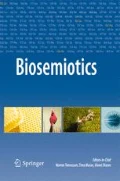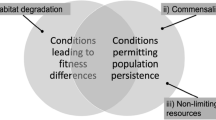Abstract
The concept of ‘semiotic fitting’ is what we provide as a model for the description and analysis of the diversity dynamics and nativeness in semiotic systems. One of its sources is the concept of ‘ecological fitting’ which was introduced by Daniel Janzen as the mechanism for the explanation of diversity in tropical ecosystems and which has been shown to work widely over the communities of various types. As different from the neo-Darwinian concept of fitness that describes reproductive success, ‘fitting’ describes functional (sign) relations and aboutness. Diversity of a semiotic system is strongly dependent on the mutual fitting of agents of which the semiotic system consists. The focus on semiotic fitting means that, in the analysis of diversity, we pay particular attention to decision making (choice), functional plasticity, recognition windows, the depth of interpretation of the agents, and the categories responsible for the structure of the semiotic system. The concept of semiotic fitting has an early analogue in Jakob von Uexküll’s concept of ‘Einpassung’ (as different from ‘Anpassung’, meaning ‘evolutionary adaptation’). The close concepts of ‘semiotic fitness’, introduced by Jesper Hoffmeyer and by Stéphanie Walsh Matthews, ‘semiotic selection’, introduced by Timo Maran and Karel Kleisner, and ‘semiotic niche’, introduced by Hoffmeyer, provide different versions of the same model. If community is constructing itself on the basis of (relational) fitting, then nativeness of the community is a product of fitting, not vice versa. Nativeness is a feature that deepens in the course of community succession. The concept of ‘semiotic fitting’ demonstrates the possibility to analyse the role of both indigenous and alien species or other agents in a community on the basis of a single model.
Similar content being viewed by others
Notes
The expression ‘set of species’ means in this article “the local set of organisms that belong to various species” (which is equivalent to ‘set of coenopopulations’).
I mean that sign relations (and codes) are preserved due to restorable mediators.
However, in a stationary community, fitness is same in all species — one survivor per capita per generation, independently of population number.
Because “[…] genes are usually followers, not leaders, in evolutionary change” (West-Eberhard 2003: 29).
On a history of the concept, see Chew and Hamilton 2011.
A closed system (i.e. without immigration) in which evolutionary speciation would balance the species extinction should be rather large, e.g. seemingly over 105 km2 for vascular plants (this of course depends on the heterogeneity of the area). This is certainly much larger than the area of local communities.
References
Agosta, S. J., & Klemens, J. A. (2008). Ecological fitting by phenotypically flexible genotypes: Implications for species associations, community assembly and evolution. Ecology Letters, 11(11), 1123–1134.
Bever, J. D. (2003). Soil community feedback and the coexistence of competitors: Conceptual frameworks and empirical tests. New Phytologist, 157(3), 465–473.
Brooks, D. R., León-Règagnon, V., McLennan, D. A., & Zelmer, D. (2006). Ecological fitting as a determinant of the community structure of platyhelminth parasites of anurans. Ecology, 87(7, supplement), S76–S85.
Cheung, T. (2004). From protoplasm to umwelt: Plans and the technique of nature in Jakob von Uexküll’s theory of organismic order. Sign Systems Studies, 32(1/2), 139–167.
Chew, M. K., & Hamilton, A. L. (2011). The rise and fall of biotic nativeness: A historical perspective. In D. M. Richardson (Ed.), Fifty years of invasion ecology: The legacy of Charles Elton (pp. 35–47). Chichester: Wiley-Blackwell.
Cipollini, D., & Peterson, D. L. (2018). The potential for host switching via ecological fitting in the emerald ash borer-host plant system. Oecologia, 187(2), 507–519.
Connell, J. H. (1971). On the role of natural enemies in preventing competitive exclusion in some marine animals and in rain forest trees. In P. J. den Boer & G. R. Gradwell (Eds.), Dynamics of populations: Proceedings of the advanced study institute on “dynamics of numbers in populations”. Oosterbeek, Netherlands, 7–18 September 1970 (pp. 298–312). Wageningen: Centre for Agricultural Publication and Documentation.
Connell, J. H. (1975). Some mechanisms producing structure in natural communities: A model and evidence from field experiments. In M. L. Cody & J. M. Diamond (Eds.), Ecology and evolution of communities (pp. 460–490). Cambridge: The Belknap Press of Harvard University Press.
Deacon, T. (2007). Shannon–Boltzmann–Darwin: Redefining information (part I). Cognitive Semiotics, 1, 123–148.
Deacon, T. (2011). Incomplete nature: How mind emerged from matter. New York: W.W. Norton & Company.
Ehrlich, P. R., & Raven, P. H. (1964). Butterflies and plants: A study in coevolution. Evolution, 18(4), 586–608.
Fisher, R. A. (1930). The genetical theory of natural selection. Oxford: Clarendon Press.
Gould, S. J., & Vrba, E. S. (1982). Exaptation — A missing term in the science of form. Paleobiology, 8(1), 4–15.
Hoffmeyer, J. (1997). Biosemiotics: Towards a new synthesis in biology. European Journal for Semiotic Studies, 9(2), 355–376.
Hoffmeyer, J. (1998). The unfolding semiosphere. In G. Van De Vijver, S. N. Salthe, & M. Delpos (Eds.), Evolutionary systems: Biological and epistemological perspectives on selection and self-organization (pp. 281–293). Dordrecht: Kluwer Academic.
Hoffmeyer, J. (2008a). The semiotic niche. In J. Hoffmeyer, Biosemiotics: An examination into the signs of life and the life of signs (pp. 169–211). Scranton: University of Scranton Press.
Hoffmeyer, J. (2008b). The semiotic niche. Journal of Mediterranean Ecology, 9, 5–30.
Hubbell, S. P. (2001). The unified neutral theory of biodiversity and biogeography. (Monographs in Population Biology 32.) Princeton: Princeton University Press.
Janzen, D. H. (1970). Herbivores and the number of tree species in tropical forests. The American Naturalist, 104(940), 501–528.
Janzen, D. H. (1980). When is it coevolution? Evolution, 34(3), 611–612.
Janzen, D. H. (1985). On ecological fitting. Oikos, 45(3), 308–310.
Krause, B. (2002). Wild soundscapes. Berkeley: Wilderness.
Kull, K. (2008). Semiotic ecology. In S. E. Jørgensen & B. D. Fath (Eds.), Systems ecology. Vol. 4 of Encyclopedia of ecology, 5 vols (pp. 3210–3214). Oxford: Elsevier.
Kull, K. (2010). Ecosystems are made of semiosic bonds: Consortia, umwelten, biophony and ecological codes. Biosemiotics, 3(3), 347–357.
Kull, K. (2016). The biosemiotic concept of the species. Biosemiotics, 9(1), 61–71.
Kull, Kalevi (2018a). Conversation with Dan Janzen. Schola Biotheoretica, 44, [63]70–76.
Kull, K. (2018b). Choosing and learning: Semiosis means choice. Sign Systems Studies, 46(4), 452–466.
Kull, K. (2019). Steps towards the natural meronomy and taxonomy of semiosis: Emon between index and symbol? Sign Systems Studies, 47(1/2), 88–104.
Kull, K., Kukk, T., & Lotman, A. (2003). When culture supports biodiversity: The case of wooded meadow. In A. Roepstorff, N. Bubandt, & K. Kull (Eds.), Imagining nature: Practices of cosmology and identity (pp. 76–96). Aarhus: Aarhus University Press.
Kunz, W. (2012). Do species exist: Principles of taxonomic classification. Weinheim: Wiley-Blackwell.
Leibold, M. A., & Chase, J. M. (2018). Metacommunity ecology. (Monographs in Population Biology 59.) Princeton: Princeton University Press.
Malavasi, R., Kull, K., & Farina, A. (2014). The acoustic codes: How animal sign processes create sound-topes and consortia via conflict avoidance. Biosemiotics, 7(1), 89–95.
Maran, T. (2012a). Are ecological codes archetypal structures? In T. Maran, K. Lindström, R. Magnus, & M. Tønnessen (Eds.), Semiotics in the wild (pp. 147–156). Tartu: University of Tartu Press.
Maran, T. (2012b). Fitness. In D. Favareau, P. Cobley, & K. Kull (Eds.), A more developed sign: Interpreting the work of Jesper Hoffmeyer (pp. 227–230). (Tartu Semiotics Library 10.) Tartu: Tartu University Press.
Maran, T. (2014). Place and sign: Locality as a foundational concept for ecosemiotics. In A. K. Siewers (Ed.), Re-imagining nature: Environmental humanities and ecosemiotics (pp. 79–89). Lewisburg: Bucknell University Press.
Maran, T., & Kleisner, K. (2010). Towards an evolutionary biosemiotics: Semiotic selection and semiotic co-option. Biosemiotics, 3(2), 189–200.
Masing, V. (1981). Consortia as elements of the functional structure of biocenoses. In L. Laasimer (Ed.), Anthropogenous changes in the plant cover of Estonia (pp. 64–76). Tartu: Institute of Zoology and Botany.
Montévil, M., & Mossio, M. (2015). Biological organisation as closure of constraints. Journal of Theoretical Biology, 372, 179–191.
Paterson, H. E. H. (1993). Evolution and the recognition concept of species: Collected writings. Baltimore: The Johns Hopkins University Press.
Petermann, J. S., Fergus, A. J. F., Turnbull, L. A., & Schmid, B. (2008). Janzen-Connell effects are widespread and strong enough to maintain diversity in grasslands. Ecology, 89(9), 2399–2406.
Reinke, J. (1872). Ueber die anatomischen Verhältnisse einiger Arten von Gunnera L. Nachrichten von der Königl. Gesellschaft der Wissenschaften und der Georg-Augusts-Universität zu Göttingen, 9, 100–108.
Uexküll, J. von (1927). Die Einpassung. In A. Bethe, G. von Bergmann, G. Embden, & A. Ellinger (Eds.), Handbuch der normalen und pathologischen Physiologie: Mit Berücksichtigung der experimentellen Pharmakologie (Vol. 1, pp. 693–701). Berlin: J. Springer.
Uexküll, J. von (1928). Theoretische Biologie (2nd ed.). Berlin: J. Springer.
Uexküll, J. von (1957 [1934]). A stroll through the worlds of animals and men. In C. H. Schiller (Ed. and trans.), Instinctive behavior: The development of a modern concept (pp. 5–80). New York: International Universities Press.
Walsh Matthews, S. (2016). How fit is the semiotic animal? The American Journal of Semiotics, 32(1/4), 205–217.
Weible, D. (2013). Approaching a semiotics of exaptation: At the intersection between biological evolution and technological development. Sign Systems Studies, 41(4), 504–527.
West-Eberhard, M. J. (2003). Developmental plasticity and evolution. Oxford: Oxford University Press.
Wu, J., & Vankat, J. L. (1991). A system of dynamic model of island biogeography. Bulletin of Mathematical Biology, 53(6), 911–940.
Zhu, Y., Getzin, S., Wiegand, T., Ren, H., & Ma, K. (2013). The relative importance of Janzen-Connell effects in influencing the spatial patterns at the Gutianshan subtropical forest. PLoS One, 8(9), e74560.
Acknowledgements
To Daniel Janzen, Riin Magnus, Timo Maran, Stéphanie Walsh Matthews, Terrence Deacon and Claudio J. Rodríguez Higuera for inspiring conversations. The work is a part of the project PRG314.
Author information
Authors and Affiliations
Corresponding author
Additional information
Publisher’s Note
Springer Nature remains neutral with regard to jurisdictional claims in published maps and institutional affiliations.
Rights and permissions
About this article
Cite this article
Kull, K. Semiotic Fitting and the Nativeness of Community. Biosemiotics 13, 9–19 (2020). https://doi.org/10.1007/s12304-020-09375-y
Received:
Accepted:
Published:
Issue Date:
DOI: https://doi.org/10.1007/s12304-020-09375-y




